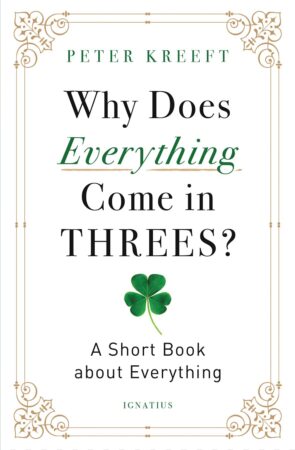Why Does Everything Come in Threes: A Short Book About Everything
Peter Kreeft (Ignatius, $22, 146 pages)
 Peter Kreeft, a modern-day G.K. Chesterton, has a delightful meditation on the persistence of important things coming in threes, modeled on the Trinity of Father, Son, and Holy Spirit. The Trinity, asserts Kreeft “is the most practical thing in the world,” the First Cause, the Final End, and the Way for Everything. God in His infinite wisdom reinforces the Trinity through a “common Trinitarian structure of everything, of the whole universe, and the human life in it.” The physical universe is Trinitarian with matter, time and space. In time, there is past, present, and future. Space has three dimensions, height, width, and depth. Matter is composed of energy, mass, and motion. Analogically, time is like the Holy Trinity, in that just as God is the Father and Son and Holy Spirit, likewise time was once future and will be past. Families are Trinitarian with father, mother, and children. Analogies abound. It is not only God’s creation that is Trinitarian; much of human creation is, too. Stories have plots, characters and setting. Most stories have three archetypical characters, the king (rule), the prophet (wisdom), and the priest (humble service), and if a story does not have all three, the three roles are often combined one character. These roles line up with God the ruler, Christ the humble servant, and the Holy Spirit’s wisdom. Kreeft lists the triad in books ranging from the Harry Potter series and The Lord of the Rings and in popular entertainment like Jaws and Star Trek. From Gandalf, Aragorn, and Frodo, to Kirk, Spock, and McCoy, human creators seem incapable of avoiding the Trinity; it is no coincidence that “pagan epics” like The Iliad and Gilgamesh “always have a single protagonist.” Kreeft relentlessly hits readers with examples of three – Aristotle and Plato’s three kinds of intellect; Freud’s super-ego, id, and ego; the three type of sentences (declarative, imperative, exclamatory) and three different kinds of parts of speech (nouns and the adjectives that describe them, verbs and the adverbs that modify them, and conjunctions and prepositions that relate nouns or verbs to other nouns and verbs); the three acts of the mind (understanding, judging, reasoning); the three stages of life (life, death, and resurrection); three possibilities after death (Heaven, Hell, Purgatory). Why Does Everything Come in Threes is delightful, simple, and deep, and it will help us understand the necessity to pursue and appreciate the good, true, and beautiful – another trinity — by becoming more aware of the significance of threes and their connection to the Holy Trinity.
Peter Kreeft, a modern-day G.K. Chesterton, has a delightful meditation on the persistence of important things coming in threes, modeled on the Trinity of Father, Son, and Holy Spirit. The Trinity, asserts Kreeft “is the most practical thing in the world,” the First Cause, the Final End, and the Way for Everything. God in His infinite wisdom reinforces the Trinity through a “common Trinitarian structure of everything, of the whole universe, and the human life in it.” The physical universe is Trinitarian with matter, time and space. In time, there is past, present, and future. Space has three dimensions, height, width, and depth. Matter is composed of energy, mass, and motion. Analogically, time is like the Holy Trinity, in that just as God is the Father and Son and Holy Spirit, likewise time was once future and will be past. Families are Trinitarian with father, mother, and children. Analogies abound. It is not only God’s creation that is Trinitarian; much of human creation is, too. Stories have plots, characters and setting. Most stories have three archetypical characters, the king (rule), the prophet (wisdom), and the priest (humble service), and if a story does not have all three, the three roles are often combined one character. These roles line up with God the ruler, Christ the humble servant, and the Holy Spirit’s wisdom. Kreeft lists the triad in books ranging from the Harry Potter series and The Lord of the Rings and in popular entertainment like Jaws and Star Trek. From Gandalf, Aragorn, and Frodo, to Kirk, Spock, and McCoy, human creators seem incapable of avoiding the Trinity; it is no coincidence that “pagan epics” like The Iliad and Gilgamesh “always have a single protagonist.” Kreeft relentlessly hits readers with examples of three – Aristotle and Plato’s three kinds of intellect; Freud’s super-ego, id, and ego; the three type of sentences (declarative, imperative, exclamatory) and three different kinds of parts of speech (nouns and the adjectives that describe them, verbs and the adverbs that modify them, and conjunctions and prepositions that relate nouns or verbs to other nouns and verbs); the three acts of the mind (understanding, judging, reasoning); the three stages of life (life, death, and resurrection); three possibilities after death (Heaven, Hell, Purgatory). Why Does Everything Come in Threes is delightful, simple, and deep, and it will help us understand the necessity to pursue and appreciate the good, true, and beautiful – another trinity — by becoming more aware of the significance of threes and their connection to the Holy Trinity.




